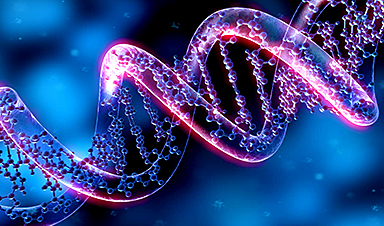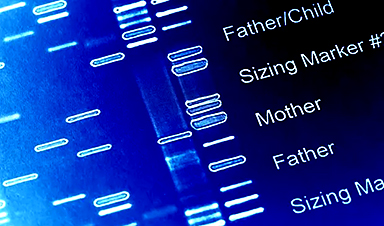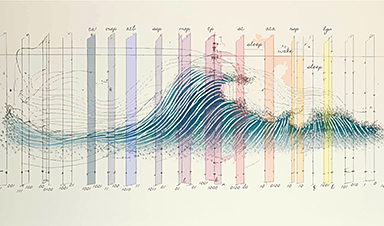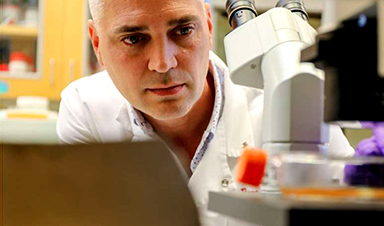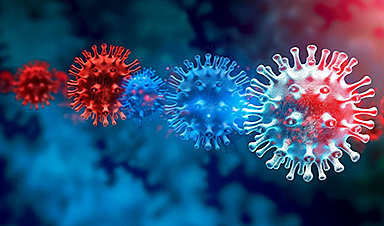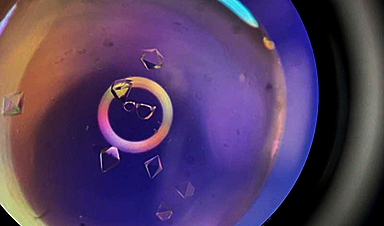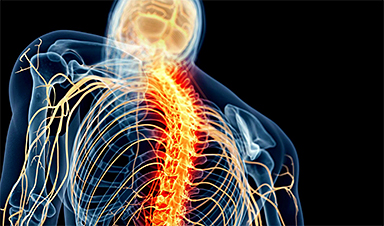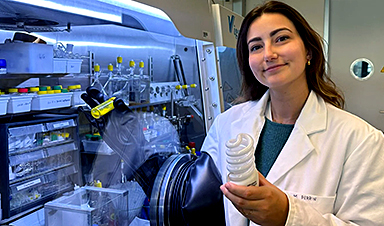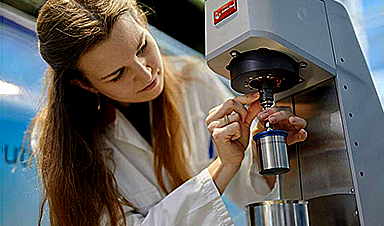Biological computing machines, such as micro and nano-implants that can collect important information inside the human body, are transforming medicine. Yet, networking them for communication has proven challenging. Now, a global team, including EPFL researchers, has developed a protocol that enables a molecular network with multiple transmitters.
“Overall, this is a very, very exciting research field,” explained Assistant Professor Haitham Al Hassanieh, head of the Laboratory of Sensing and Networking Systems in EPFL’s School of Computer and Communication Sciences (IC). “With advances in bio-engineering, synthetic biology, and nanotechnology, the idea is that nano-biosensors will revolutionize medicine because they can reach places and do things that current devices or larger implants can’t,” he continued.
Yet no matter how exciting this cutting-edge research field is, there remains a huge, fundamental challenge—when you have a nano-robot in someone’s body, how will you communicate with it? Traditional techniques, like wireless radios, work well for large implants such as pacemakers or defibrillators but can’t be scaled to micro and nano-dimensions, and wireless signals don’t penetrate through body fluids.
Enter what’s being called biomolecular communication, inspired by the body itself. It doesn’t utilize electromagnetic waves but biological molecules both as carriers and as information, mimicking the existing communication mechanisms in biology. In its simplest form it encodes “1” and “0” bits by releasing or not releasing molecular particles into the bloodstream—similar to ON-OFF-Keying in wireless networks.
“Biomolecular communication has emerged as the most suitable paradigm for networking nano-implants. It’s an incredible idea that we can send data by encoding it into molecules which then go through the bloodstream and we can communicate with them, guiding them on where to go and when to release their treatments, just like hormones,” Al Hassanieh said.
Recently, Al Hassanieh and his team, in collaboration with researchers in the United States presented their paper, “Towards Practical and Scalable Molecular Networks,” at ACM SIGCOMM 2023, an annual conference on Data Communication, in which they outlined their MoMA (Molecular Multiple Access) protocol that enables a molecular network with multiple transmitters.
“Most existing research is very theoretical and doesn’t work because the theories haven’t considered biology,” explained Al Hassanieh. “For example, every time the heart pumps there’s a jitter and the body changes its internal communication channel. Most existing theory assumes that the channel that you send the molecules over is very stable and doesn’t change. It actually changes very fast.”
With MoMA, the team introduced packet detection, channel estimation, and encoding/decoding schemes that leverage the unique properties of molecular networks to address existing challenges. They evaluated the protocol on a synthetic experimental testbed—emulated blood vessels with tubes and pumps—demonstrating that it can scale up to four transmitters while significantly outperforming state-of-the-art technology.
The researchers acknowledge that their current synthetic testbed may not capture all the challenges associated with designing protocols for molecular networks and that in-vivo testing of micro-implants and micro-fluids in wet-labs is needed to achieve practical and deployable molecular networks. However, they believe they have taken the first steps towards this vision and that their insights for designing molecular networks will hold, as the underlying diffusion and fluid dynamics models in their testbed are fundamental to molecular communication
“I am very excited about this area because it’s a new form of communication. We are a systems group, we like building things and getting them working. It’s taken time to develop the expertise we have in biomolecular communication but now we are at the stage where we are finding collaborators and can get things moving. People think this is science fiction but it’s fast moving to science fact,” Al Hassanieh concluded.
More information: Jiaming Wang et al, Towards Practical and Scalable Molecular Networks, Proceedings of the ACM SIGCOMM 2023 Conference (2023). DOI: 10.1145/3603269.3604881
News
The Silent Battle Within: How Your Organs Choose Between Mom and Dad’s Genes
Research reveals that selective expression of maternal or paternal X chromosomes varies by organ, driven by cellular competition. A new study published today (July 26) in Nature Genetics by the Lymphoid Development Group at the MRC [...]
Study identifies genes increasing risk of severe COVID-19
Whether or not a person becomes seriously ill with COVID-19 depends, among other things, on genetic factors. With this in mind, researchers from the University Hospital Bonn (UKB) and the University of Bonn, in [...]
Small regions of the brain can take micro-naps while the rest of the brain is awake and vice versa
Sleep and wake: They're totally distinct states of being that define the boundaries of our daily lives. For years, scientists have measured the difference between these instinctual brain processes by observing brain waves, with [...]
Redefining Consciousness: Small Regions of the Brain Can Take Micro-Naps While the Rest of the Brain Is Awake
The study broadly reveals how fast brain waves, previously overlooked, establish fundamental patterns of sleep and wakefulness. Scientists have developed a new method to analyze sleep and wake states by detecting ultra-fast neuronal activity [...]
AI Reveals Health Secrets Through Facial Temperature Mapping
Researchers have found that different facial temperatures correlate with chronic illnesses like diabetes and high blood pressure, and these can be detected using AI with thermal cameras. They highlight the potential of this technology [...]
Breakthrough in aging research: Blocking IL-11 extends lifespan and improves health in mice
In a recent study published in the journal Nature, a team of researchers used murine models and various pharmacological and genetic approaches to examine whether pro-inflammatory signaling involving interleukin (IL)-11, which activates signaling molecules such [...]
Promise for a universal influenza vaccine: Scientists validate theory using 1918 flu virus
New research led by Oregon Health & Science University reveals a promising approach to developing a universal influenza vaccine—a so-called "one and done" vaccine that confers lifetime immunity against an evolving virus. The study, [...]
New Projects Aim To Pioneer the Future of Neuroscience
One study will investigate the alterations in brain activity at the cellular level caused by psilocybin, the psychoactive substance found in “magic mushrooms.” How do neurons respond to the effects of magic mushrooms? What [...]
Decoding the Decline: Scientific Insights Into Long COVID’s Retreat
Research indicates a significant reduction in long COVID risk, largely due to vaccination and the virus’s evolution. The study analyzes data from over 441,000 veterans, showing lower rates of long COVID among vaccinated individuals compared [...]
Silicon Transformed: A Breakthrough in Laser Nanofabrication
A new method enables precise nanofabrication inside silicon using spatial light modulation and laser pulses, creating advanced nanostructures for potential use in electronics and photonics. Silicon, the cornerstone of modern electronics, photovoltaics, and photonics, [...]
Caught in the actinium: New research could help design better cancer treatments
The element actinium was first discovered at the turn of the 20th century, but even now, nearly 125 years later, researchers still don't have a good grasp on the metal's chemistry. That's because actinium [...]
Innovative Light-Controlled Drugs Could Revolutionize Neuropathic Pain Treatment
A team of researchers from the Institute for Bioengineering of Catalonia (IBEC) has developed light-activated derivatives of the anti-epileptic drug carbamazepine to treat neuropathic pain. Light can be harnessed to target drugs to specific [...]
Green Gold: Turning E-Waste Into a Treasure Trove of Rare Earth Metals
Scientists are developing a process inspired by nature that efficiently recovers europium from old fluorescent lamps. The approach could lead to the long-awaited recycling of rare earth metals. A small molecule that naturally serves [...]
Cambridge Study: AI Chatbots Have an “Empathy Gap,” and It Could Be Dangerous
A new study suggests a framework for “Child Safe AI” in response to recent incidents showing that many children perceive chatbots as quasi-human and reliable. A study has indicated that AI chatbots often exhibit [...]
Nanoparticle-based delivery system could offer treatment for diabetics with rare insulin allergy
Up to 3% of people with diabetes have an allergic reaction to insulin. A team at Forschungszentrum Jülich has now studied a method that could be used to deliver the active substance into the [...]
Nanorobot kills cancer cells in mice with hidden weapon
Researchers at Karolinska Institutet in Sweden have developed nanorobots that kill cancer cells in mice. The robot's weapon is hidden in a nanostructure and is exposed only in the tumor microenvironment, sparing healthy cells. [...]

